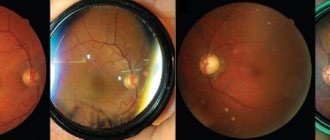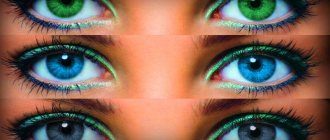Veil in the eyes - what is it?
A blurred vision is a visual impairment in which a person sees as if through a cloudy glass.
Blindness in the eyes can be an unstable symptom and appear periodically. In some cases, the appearance of a veil on the eyes may be accompanied by additional signs and symptoms:
●increased sensitivity to light (photophobia)
●pain in the eyes
●the appearance of a veil before a person’s eyes only at night
●floating spots or spots before the eyes
●sudden weakness and numbness in one half of the body
●increase in body temperature
Seek immediate medical attention if blurred vision occurs along with any of the symptoms listed above.
There are many reasons for the appearance of a veil in the eyes or in front of one eye. Let's look at the main ones.
1.Refractive eye problems
. Diseases such as myopia, farsightedness, astigmatism. The appearance of a veil in this case is associated with improper focusing of the image on the retina. When choosing glasses or contact lenses, this symptom goes away.
2.Presbyopia
. This is the cause of decreased near vision in people over 40 years of age. Associated with changes in the optical properties of the lens. First, a slight decrease in vision appears when reading in front of one eye, and after some time - in front of the other eye. Treatment for blurred vision due to presbyopia involves choosing reading or distance glasses.
3.Dry eye syndrome.
Very often, the cause of the appearance of a white veil before the eyes is dry eyes. The cornea dries out and the corneal endothelium becomes foggy, leading to blurred vision. The veil does not cover the eyes all the time, but only under certain conditions. The use of moisturizing drops and gels quickly solves this problem in case of dry eye syndrome.
4.Cataract
. Cloudiness of the lens is the most common cause of veil in one eye in older people. An operation to replace the old lens with a new (artificial) one relieves a person of cataracts, and therefore of fog in front of the eye.
5.Glaucoma.
An increase in intraocular pressure causes a sharp decrease in vision and the appearance of a white veil in the eyes. In case of glaucoma, this is a very bad sign and requires immediate treatment from a specialist doctor.
6.Age-related macular degeneration
. The most common cause of central vision loss in people over 60 years of age. Blurred vision occurs when reading and looking at objects at close range. At first the eye sees poorly, as if a veil appears before the eye, then a distortion of lines and objects appears. Treatment for macular degeneration will help reduce these symptoms of the disease.
7. Hemophthalmos
. Intraocular bleeding is one of the most dangerous causes. The sudden appearance of a red veil in front of the eye may be a symptom of hemophthalmos. It occurs in diabetes and hypertension. Treatment is carried out in a hospital setting and is aimed at resolving the hemorrhage. In some cases, surgery is necessary.
8. Optic neuritis
. Inflammation of the optic nerve leads to decreased vision and the appearance of blurred vision. Vision is completely restored after the course of treatment. However, the sudden appearance of a white veil in front of the eye may be an early sign of a relapse of the disease.
9. Migraine.
Before a migraine attack, a dark veil may appear in the eye. After the attack, vision is completely restored. In this case, migraine treatment is necessary.
10.Stroke or transient ischemic attack
. Poor circulation in the vessels of the brain may be accompanied by similar eye symptoms. In these cases, the underlying disease is treated under the supervision of ophthalmologists.
11. Brain tumors
. In rare cases, a veil over one eye may indicate problems in the brain.
12.Medicines
. Chronic use of certain medications can cause blurred vision. These include:
●antidepressants
●oral contraceptives
●anticholinergic drugs
●corticosteroid drugs
●heart medications
Consultation with an ophthalmologist is necessary if blurred vision appears before the eyes while taking medications.
“The appearance of a veil before the eyes should not be ignored. Therefore, if you experience this symptom, you should visit your eye doctor as soon as possible.”
When visiting your doctor, be sure to ask the following questions:
- Why did I have a veil before my eyes?
- What to do if the veil appears on the eye again?
- When is it necessary to come for a re-examination?
- Should I wear glasses all the time to get rid of the blurry vision?
- Has my glasses (contact lenses) prescription changed?
Causes associated with diseases
If a floating film appears in the eye, this may be a sign of the development of pathological processes in the organs of vision. Therefore, if such symptoms appear, you should definitely consult a doctor. Especially if they do not go away for a long time.
Losing Focus
Impaired focusing occurs against the background of astigmatism, myopia, and farsightedness. A person sees blurry images at different distances. There may be a splitting of objects and their vagueness. Each of these pathologies requires correction and specific treatment.
Presbyopia
In most cases, this disorder occurs in patients over 40 years of age. In this case, a person has difficulty reading near. Presbyopia develops gradually. Initially, vision in one eye deteriorates. If treatment is not taken promptly, damage to both eyes will occur. The patient is prescribed wearing optical products and supportive therapy.
Cataract
Cataracts are a dangerous ophthalmological disease.
If you do not consult a doctor in a timely manner, this can lead to complete loss of vision. Cloudiness of the lens gradually occurs. Lack of therapy leads to complete clouding. The severe stage of this disease can be cured only by a single method - surgery.
Glaucoma
Glaucoma is also a dangerous eye disease. Initially, a short blurred vision appears. The duration of such unpleasant symptoms gradually increases. Visual impairment is only an accompanying symptom. Glaucoma is dangerous due to increased intraocular pressure. It is not recommended to ignore such manifestations. Timely diagnosis will help preserve vision.
Macular degeneration
This pathology occurs in elderly patients over 60 years of age. The reason lies in long-term work with small objects nearby. For example: needlework, long reading, working with documents and at the computer. Initially, slight clouding appears, objects do not have clear outlines.
Hemophthalmos
The disease is very dangerous because it is accompanied by internal bleeding in the eye. In this case, the cloudiness is red. Patients who suffer from diabetes and hypertension are at risk of developing hemophthalmos.
Neuritis
Neuritis has different etiologies. Accompanied by inflammatory processes in the nerves of the visual organs.
The reason lies in excessive loads. There is visual impairment in the form of blurred objects and the inability to focus on them. If a relapse of the disease occurs, the film tends to be very dense and may appear unexpectedly.
Migraine
Migraine attacks are accompanied by painful sensations when focusing vision. Pain may occur when exposed to bright light. Migraine is an unpleasant disease.
Why does discharge appear in the eyes?
Let's look at the reasons why yellow, white and other discharge appears in the corners of the eyes:
- Diseases of the visual organ of inflammatory and non-inflammatory nature.
- Allergic reactions. Occurs when exposed to an allergen. This could be decorative cosmetics, eye creams, makeup remover. As well as other allergens: food, dust, industrial, etc.
- White discharge in the corners of the eyes in the morning can be caused by excess dust particles. They accumulate and are then released during sleep.
- High load on the visual organ. Symptoms appear as part of dry eye syndrome.
Possible diseases
By the nature of the discharge, one can determine the disease of the visual organ. Periodically appearing white discharge from the eyes in the morning, not accompanied by signs of inflammation, is normal. If they become regular and other complaints appear, then the development of an ophthalmological disease is likely.
- White mucous discharge from the eyes is characteristic of viral diseases (viral conjunctivitis), and is possible after an acute respiratory viral infection. Additionally, redness of the mucous membrane and sclera, lacrimation, photophobia, swelling, as well as signs of a cold (coughing, sneezing, elevated body temperature) are noted. When the virus first affects one visual organ, then the second one joins.
- Another reason is dry eye syndrome. It manifests itself as dryness and fatigue of the visual organ. Occurs after prolonged hard work at the computer or with small objects.
- Liquid transparent. This is a sign of an allergy (allergic conjunctivitis). The defeat is two-sided. Accompanied by severe itching. The eyelids turn red and swell. After eliminating the allergen, the symptoms subside.
- Transparent liquid discharge is possible when dust or foreign bodies enter the discharge. It is a protective reaction of the body. The goal is to remove foreign particles mechanically.
- Yellow abundant. Appear due to inflammation of the lacrimal sac - dacryocystitis. The discharge is copious and thick. It intensifies when massaging the affected area.
- Greenish or yellowish foamy discharge is most often found with blepharitis, an inflammation of the eyelid. Accompanied by itching, peeling, swelling of the eyelids. The discharge from the eyes is sticky, accumulates in the morning, sticks together the eyelashes, and forms dense scales and crusts. Other causes are eye infections, a reaction to a dust mite.
- Thick yellow, green with a gray or brown tint is a sign of inflammation, formed due to the accumulation of leukocytes. Characteristic of bacterial conjunctivitis, viral and fungal infections of the cornea, trachoma, opening of barley. Additionally, there is the formation of dense crusts that are difficult to remove. A film forms on the eye, which interferes with the clarity of vision. There are redness, swelling, lacrimation, and photophobia. In severe cases - pain in the eyeball, headache, increased body temperature.
- Thread-like discharge is characteristic of filamentous keratitis. This is a disease that occurs when the function of the lacrimal glands is reduced. It manifests itself as dryness, burning, thread-like discharge, redness of the sclera. Leads to dystrophic changes in the cornea.
Why does eye discharge accumulate in the corner? This is due to the anatomical structure of the organ of vision. The corner is somewhat recessed in the orbit relative to other structures. It is convenient for liquids to flow there. The outlet of the nasolacrimal duct is also located there. When it becomes inflamed, pus comes out in the corner.
Why might this be a problem?
The feeling that you are looking at the world through cloudy and dirty glass is often caused by disorders in the retina when any deformation changes have occurred. As a result, the image formation occurs incorrectly. This symptom should not be ignored; it may be associated with serious pathologies of human vision. Only timely treatment will eliminate the problem without serious functional impairment. Sometimes the veil is not associated with problems with the eyes, but is caused by the development in the body of problems in the performance of the heart and nervous pathologies.
The feeling of fog or shroud can be caused by the following problems:
- Poor circulation, decreased elasticity of blood vessels, their fragility. Circulatory problems are a vascular problem. The pathology is mostly temporary – it does not last long, after which the patient’s condition returns to normal. Disturbances may also be accompanied by severe pain in the head and general weakness throughout the body. The appearance of a problem with the veil may indicate that some serious diseases are worsening in the body (diabetes mellitus, high blood pressure, excessive blood clots).
- Cataract. The veil does not appear immediately during the disease; this is due to the fact that cataracts develop very slowly and at an early stage practically do not manifest themselves at all. With cataracts, the density of the veil before the eyes increases every time, this is due to the development of destructive processes in the lens. Cataracts are quite common in the modern world, and medicine successfully fights the problem; even in advanced cases, the patient manages to regain vision.
- Glaucoma. Disease
develops quite sharply and is accompanied by an increase in eye pressure. The problem is accompanied not only by a veil before the eyes, but also by severe localized pain in the head in the eye area. - Problems with the cornea. The cornea in the human eye is a rather fragile structure that is easily damaged as a result of ordinary mechanical trauma or in the absence of proper treatment for inflammation in the organs of vision. Problems with the cornea are almost always accompanied by the appearance of a veil.
- Myopia. A disease in which the organs of vision begin to function incorrectly. The problem rarely manifests itself as just a veil; many accompanying symptoms also occur.
- Retinal detachment. Often develops against the background of chronic diseases, such as diabetes.
Remember that blurred vision is not always caused by problems with the organ of vision. If you hit your head hard and then experience an unpleasant symptom, most likely a concussion was caused during the impact. If a symptom appears in this case, you must immediately contact the emergency room, where you will be sent for a medical examination to make an accurate diagnosis.
Impaired vision clarity is often associated with the development of a stroke, in which the process of enriching the brain with blood and oxygen is disrupted. If a veil appears before the eyes due to a stroke, further treatment is carried out under the strict supervision of an ophthalmologist.
A haze before the eyes often indicates that malignant or benign tumors are developing in the brain area.
Taking certain medications on a regular basis can also cause problems (antidepressants, vascular medications, contraceptives, hormonal medications, cardiovascular medications). Blurred vision can be caused by allergies. In this case, the problem appears in the morning after sleep. If the eye is washed with water, not a trace remains of the veil. The problem is most likely due to the fact that somewhere near the bed there are objects that cause allergic reactions.
If a veil appears before your eyes after removing makeup with one or another cosmetic product, most likely your body is intolerant to some component of the product. In this case, getting rid of the veil is extremely simple - just choose a suitable and safe makeup remover.
Therapeutic measures
If the doctor has detected retinal detachment, he will prescribe medications to help restore vascular patency. Separately, medications are prescribed to improve retinal metabolism. If the veil on the eyes does not go away, an operation is recommended, during which the retina is “welded” to the choroid. Keratitis requires medical treatment. In this case, agents are used to help destroy microbes. The goal of therapy is also to eliminate the infection. Depending on the nature of the disease, injections may be required. If the cornea is severely damaged, transplant surgery is recommended.
Treatment of immature cataracts involves instillation of drops with vitamins. Cataracts should not be allowed to develop and become mature! If your doctor recommends a lens transplant surgery, you need to listen to his advice. For mature cataracts, a procedure is prescribed during which the lens is replaced with a lens.
Preventive measures
Regular hygiene of the visual organs will help to avoid the manifestation of dangerous diseases and reduce eye fatigue at the end of the working day. Recommendations from qualified ophthalmologists:
- regular visits to an ophthalmologist at least once a year for general diagnostics of the visual organs;
- mandatory washing and disinfection of hands before working with the mucous membranes of the eyes (putting on/removing contact lenses, for example);
How to put on and remove contact lenses
- doing eye exercises and resting for about 10 minutes while constantly working at the computer. The eyes should rest at least once every hour and a half;
- use of clean and intact (without scratches, chips) sunglasses to protect from direct sunlight;
- When working in a dusty industry or in bright daylight, mandatory eye protection from irritants is required (plastic glasses or a mask that completely limits the access of the irritant to the organs of vision and the area around the eyes).
Eyes should be washed regularly with clean water
Video: An effective remedy for the feeling of film in the morning
Since a person receives about 90% of all information through vision, it is necessary to pay attention to even such minor changes as blurred vision at the end of the working day. Timely identification of the cause of vision problems will help avoid the development of serious diseases
Features of manifestation
- 3.1 Focusing problems
- 5.1 Traditional medicine
- 6.1 Video: An effective remedy for the feeling of film in the morning
The feeling of a veil before the eyes is also called the condition of “tired” eyes. As a rule, this symptom manifests itself:
- after a hard day at work;
- in the morning with insufficient adaptation to bright sunlight;
- after working with electronic devices (computers, smartphones, tablets) for a long time.
The reasons for the feeling of a film on the eye can be different.
Usually this condition is temporary and goes away within a couple of hours after changing activities. If blurred vision accompanies you for a long period, there is reason to think about the presence of diseases or a change in occupation.
In some cases, the veil is accompanied by the following symptoms:
- redness of the whites of the eyes;
- fatigue of the eye muscles;
- itching;
- dryness of the mucous membranes of the eyeball;
- general weakness;
- interference with vision - flying spots, ripples, “floaters” before the eyes;
- problems with perception of bright daylight.
Types of flies before your eyes
The veil can be observed in one or both eyes at the same time.
Causes of foggy eyes
In most cases, the causes of blurred vision are exclusively ophthalmological in nature, including:
- Cloudiness of the lens, characteristic of cataracts. In patients aged sixty years and older, this is the most common cause of foggy vision, and it can occur in one or both eyes.
- Opacities on the cornea. This can occur both due to pathologies of an inflammatory nature, and as a result of burns (thermal and chemical), injuries of various origins and degenerative processes.
- Pathologies affecting the optic nerve. In this case, fogging is the very first and relatively “harmless” symptom, and after some time, in addition to the uncomfortable fog, the patient may also experience pain.
- Retinal lesions. This includes all types of uveitis, diabetic retinopathy, chorioretinitis and macular degeneration.
Very often, fog occurs due to refractive errors such as astigmatism, farsightedness or nearsightedness.
Remember! As a rule, the problem is solved with the start of using optics, but if even when putting on contact lenses, a person’s fogging does not go away, this is a reason to look for the cause in other ophthalmological pathologies.
Risk group
Treatment of any disease begins with establishing the cause of its occurrence. Although this seems surprising, even today doctors cannot clearly identify the categories of people who are at greater risk of contracting this disease than others. People of all ages are equally susceptible to it, not only young children, but also older people. It is necessary to minimize exposure to factors that cause the disease.
If inflammatory processes constantly develop in the conjunctival membrane of the eye, then the vessels will suffer, and over time a white film will appear on the eyes. With regular and intense exposure, the shape of the epithelium located on the outer shell will begin to change. This leads to the growth of connective tissue; over time, fibroblasts penetrate the cornea, and they already cause the formation of a cloudy film in the eyes.
Film on the eyes of a newborn
Obstruction of the tear ducts is the main reason why babies have a film on their eyes. This is a rare disease, dacryocystitis, which occurs in 5% of infants.
The reasons for its occurrence:
- abnormal development of the tear ducts;
- absence of a tear duct;
- injury to the face with obstetric forceps.
During the period of intrauterine growth, the baby's nasolacrimal ducts are blocked by a gelatinous film. It prevents amniotic fluid from entering the respiratory tract. With the first cry of the newborn, the film should break, and if this does not happen, the tear duct remains closed. Pathology leads to congestion in the lacrimal sac, causing inflammation of the eyes.
Signs of dacryocystitis can be easily noticed not only by the pediatrician, but also by the mother:
- tears flowing without crying;
- purulent discharge in the corners of the eyes;
- redness and swelling of the lower part of the eye.
An ophthalmologist should diagnose the disease and prescribe treatment after examining the newborn. Drugs are prescribed to relieve symptoms of inflammation. The therapy uses antiseptic rinsing, eye drops and massage. As the baby grows, the film should break by 6-12 months; if this does not happen, a surgical incision will be required.
More rarely, the cause of the appearance of the film is lipodermoid. This is a movable light yellow elastic fold located on the outside of the eye. It is a congenital pathology and does not increase during life. The formation is firmly connected to the lacrimal gland, so its removal is rarely performed.
Other factors
Working at a computer for several hours causes dry eyes and irritation of the mucous membranes. The conjunctiva reacts very sharply to almost any impact, because it contains many blood vessels, as well as nerves. The mucosa consists of several layers: epithelium and submucosa.
The conjunctiva of the eyes performs several functions at once. Inside it is a gland that produces tear fluid. The mucous membrane moisturizes the eyes and protects them from the negative effects of the environment. With prolonged exposure to an irritating factor, transformation of the epithelium occurs. As a result, connective tissue begins to grow and a film closes the eyes.
Treatment options
It is impossible to completely get rid of the film on the cornea using medications or alternative medicine. The disease can only be eliminated through surgery.
Conservative treatment
Conservative therapy with medications and folk remedies is used as a supplement, as well as in the early stages of the development of pathology.
Vasoconstrictors and vasodilators in the form of drops and ointments, as well as drugs that help relieve fatigue and irritation (for example, Visin, Albucid) will help reduce inflammation and swelling. In addition, moisturizing drops based on artificial tears, as well as anti-inflammatory medications, can be prescribed.
You can relieve dryness, irritation and inflammation of the conjunctiva using decoctions of chamomile, yarrow, linden in the form of compresses and rinses.
Operation
The operation is performed when the film increases in size and the general condition of the patient worsens. 24 hours before surgery, the patient is prohibited from using aspirin and other drugs that affect the blood.
Removal of the growth is carried out under local anesthesia. The whole process takes about half an hour.
The triangular formation can be removed with a scalpel or laser. Many surgeons prefer the laser method of excision: it avoids bleeding, is accompanied by less unpleasant sensations, does not leave behind stitches, and also has a shorter rehabilitation period.
After the operation, the patient requires medical supervision, so he is left in the hospital for several hours.
In the postoperative period, a bandage is applied to the eye. To avoid inflammatory processes, antibacterial agents are used (Levomycetin, Tobrex, etc.). If severe pain occurs, painkillers are prescribed. Do not rinse your eyes with water during the day.
Advanced stages of the disease are very difficult to treat. In this case, the film almost completely covers the pupil, which makes it impossible to recognize surrounding objects. At this stage, the operation does not guarantee the return of vision, since the growth grows tightly into the cornea. Trying to detach it may result in loss of transparency of the lens.
Treatment for foggy eyes
There is no treatment for eye fog as such.
When contacting an ophthalmologist and after performing all the necessary tests, the doctor must establish the root cause why the patient has such visual impairment.
It is possible that the treatment will be transferred to another specialist: for example, if diabetes is the cause of the fog, the endocrinologist is competent to give the patient recommendations on proper nutrition and prescribe insulin and other appropriate medications.
Sometimes the cause of fog can be pathological processes in the brain. In this case, a neurologist or oncologist comes into play.
In this case, the patient is additionally prescribed an MRI and CT scan of the brain, since tumors that arise near the visual centers of the brain can also influence the development of such vision defects.
Need to know! The simplest case is refractive error: just choose the right glasses or contact lenses and the problem will be resolved.
Interestingly, the correct selection of optics for the initial stage of cataracts in many cases also eliminates this disorder.
Treatment of the veil
To prescribe the correct treatment, it is necessary to identify the cause of the veil. To do this, you should make an appointment with an ophthalmologist, where he will perform the following diagnostics:
Examination of the visual organ with a slit lamp.
- Measuring intraocular pressure.
- Examination of the fundus using an ophthalmoscope. Before this, a special drug is dripped to dilate the pupil.
- Ultrasound of the eye.
You can read about the causes of eye episcleritis in our article.
If the diagnosis does not reveal pathologies, then the doctor prescribes an additional examination:
- MRI of the head and neck;
- determination of sensitivity reflexes;
- Ultrasound of the vessels of the head and neck.
Read here what to do if blood vessels burst in your eyes.
Treatment with eye drops and tablets
Based on the examination results, appropriate treatment is prescribed:
- If the veil appears as a result of retinal detachment, then he prescribes medications that improve the functioning of blood vessels and improve metabolism in tissues. In some cases, laser surgery may be performed to solder the retina to the choroid. Laser beams are directed to specific areas of the detached retina and weld it together. The liquid that has collected under it will resolve during the rehabilitation period. The procedure itself takes from 0.5 to 2 hours and does not require hospitalization. 80% of operations end with complete restoration of vision.
- Keratitis is treated with eye drops, which kill the infection and improve nutrition of the optic nerve.
- If the cornea is damaged, a donor organ transplant may be needed.
- Cataracts are treated depending on the degree of development of the disease. In the early stages, drops with vitamins are used: Taufon, Quinax, Katahrom. Drops only temporarily remove the veil from the eyes, slowing down the process of clouding of the lens. Mature cataracts are treated surgically, replacing the biological lens - the crystalline lens.
- Glaucoma is treated with drops that reduce intraocular pressure: Pilocarpine, as well as by taking analgesics. If the disease progresses rapidly, surgery has to be performed. During an acute attack of glaucoma, a thick veil appears on the eye, which is accompanied by rainbow highlights and painful sensations. You can reduce intraocular pressure with the help of diuretics, as well as quickly contact a doctor.
- Dry eye syndrome is treated with drops whose composition is close to the natural liquid of tears: Systane Ultra, Hylamax, Hilo-chest.
- If the clouding of the eye occurs due to a brain tumor, then serious complex treatment with radiation therapy and chemotherapy is necessary.
- Hypertension is treated with special medications. If a crisis occurs, the patient must be urgently hospitalized.
- Diabetes should be treated by an ophthalmologist and an endocrinologist together. After all, when treating the underlying disease, you need drugs that will not have a destructive effect on vision.
- Anemia and low hemoglobin are treated with special medications that contain iron. A balanced diet including meat, vegetables and fruits is also necessary.
ethnoscience
If the veil is not a consequence of a serious retinal disease, glaucoma, or cataract, then you can “refresh” your vision with the help of simple exercises:
- Sit comfortably with your back straight and your gaze directed straight ahead. Then, without turning your head, turn your eyeball to the right, then to the left. Then up and then down. Repeat 5 times in each direction.
- Blink for 30-40 seconds, then close your eyes and repeat again. Do this 7 times.
- Make rotational movements with your eyeballs in one direction 5 times and in the other the same amount.
When your eyes are tired after sitting at the computer for a long time or reading a book, you can do a light massage. To do this, you need to close your eyes and use your fingertips to make circular movements along the edges of the eye orbits. This improves blood circulation and lymph flow.
Visual acuity can be restored with the help of wonderful drops of aloe and honey. To do this, you need to take 0.5 teaspoon fresh liquid honey and the same amount of aloe juice. Mix the ingredients, dilute with purified water in a 1:1 ratio and instill in the morning and evening.
Treatment
Taking into account the etiology of the disease, the doctor prescribes drug therapy. Before this, a comprehensive examination must be carried out. If the cause of the film before the eyes is hidden in the presence of cataracts, glaucoma, or retinal detachment, then patients are usually prescribed surgical intervention. If refractive error occurs, laser correction will be effective. The development of minor deviations can be corrected with glasses and contact lenses.
Inflammatory processes that are accompanied by infection are treated with medication. You can get rid of fatigue and dry eye syndrome with the help of moisturizing ophthalmic drops. These products include: Visine, Natural tear.
It is worth noting that a film on the eyes that does not go away for several days is a sign of eye disease. If the cause is hidden in fatigue or exposure to external factors, then such manifestations should disappear on their own after rest. If ophthalmological diseases are not treated in time, surgery may be necessary.
The only way to get rid of such manifestations is to consult a doctor in a timely manner. If such symptoms appeared in childhood, then a comprehensive examination of the body will be required. After this, the doctor prescribes drug therapy. Otherwise, there is a risk of partial or complete loss of vision.
Symptoms of pterygium
- Slight clouding of the periphery of the cornea, which is the first sign of developing pterygium. At this stage the patient has no complaints. There is only a mildly expressed cosmetic defect.
- The appearance of a growth on the cornea that has an opaque consistency. This growth is quite noticeable and usually grows from the side of the nose.
- The sensation of a foreign body in a particular eye, which occurs because the pterygium begins to rise above the surface of the cornea, irritating the nerve endings receptors located on the inside of the eyelid.
- Persistent eye irritation. The reason for this is the absence of a tear film on the surface of the neoplasm, as well as a violation of the formation of such a film on a healthy area of the cornea. Persistent feeling of dryness in the eye.
- Gradual decrease in visual acuity. This symptom occurs when a pterygium grows on the center of the cornea, as a result of which the passage of light into the eyeball is disrupted.
- If the pterygium is inflamed, hyperemia of the eyeball, itching, swelling of the conjunctiva, and increased lacrimation are observed.
Symptom Definition
The manifestation of a veil before the eyes.
A veil before the eyes is a visual disturbance in which a person sees as if through a cloudy glass. The symptom may be intermittent and appear only from time to time.
In some cases, the veil before the eyes may be supplemented by such manifestations as:
- Photophobia (increased sensitivity to light);
- Pain in the eyes;
- Appears only at night;
- Spots, floating spots before the eyes;
- Sudden weakness;
- Numbness in one half of the body;
- Increased body temperature.
You should immediately seek medical help if blurred vision is accompanied by the above symptoms.
Treatment of the disease
When such a disease appears, drug treatment is powerless and is not prescribed by a doctor. If the film on the eyes is of insignificant size and it is not worth operating on it, then it is monitored, it is determined whether the tumor is growing or not, and how quickly it is progressing. If the film begins to grow, it must be removed. This can only be done surgically.
This operation is performed by a qualified doctor under local anesthesia. The patient is first instilled with a special solution into the affected eye.
Surgical intervention involves the surgeon removing the growth itself on the visual apparatus. To prevent the patient from having a relapse, a special graft is inserted into the treatment area instead of the excised area. It is cut out from another section of the conjunctiva.
In order to avoid relapse, the doctor may prescribe antitumor antibiotics. The rehabilitation period after such surgery does not last long. For 48 hours, the affected area should be covered with a special bandage. In order for swelling to go away faster, you can use drops that your doctor will prescribe.
Pterygium is usually eliminated using a laser. This lengthy procedure takes no more than half an hour. The principle of surgery is very simple. It is necessary to remove the growing film down to the sclera with a laser. The advantage of the operation is that the laser not only removes the growth, but also cauterizes the ruptured blood vessels, blood stops flowing to the film, and the likelihood of relapse is minimized.
In this case, the patient also needs to walk with a bandage for some time and be sure to use anti-inflammatory drops. It is necessary to prepare for the operation. On this day, the patient is prohibited from taking aspirin and any coagulants. After the operation is performed, the person needs to stay in the hospital for several hours.
The surgical procedure is performed as follows:
- The operation is performed using local anesthesia. First of all, they introduce it. As a rule, drops with an anesthetic effect are used. A special solution with an anesthetic effect is injected into the thickness of the film itself.
- The defect is excised using a blade, after which the conjunctiva is sutured.
- After the operation, the surgeon applies a bandage with antiseptic medications to the eyes.
As a rule, surgical treatment is carried out quickly, and the patient is usually not hospitalized. After surgery, drops with anti-inflammatory effects are prescribed.
Typically, the patient does not need to follow any special measures during rehabilitation. It lasts about 2 weeks, after which the person can return to normal life.
Features of the recovery period that the patient should know about
- Painful sensations that are quite pronounced. When surgical treatment is performed, the cornea is necessarily affected, and it is the most sensitive eye shell. It is because of this that a person experiences pain, which will subside as soon as the wound heals. The pain may be accompanied by tearing, a feeling that there is a foreign body in the eye that is preventing it from opening or closing;
- During the first hours after surgery, bleeding from the conjunctival blood vessels is possible. This is a normal reaction to surgery. You just need to change the bandages in a timely manner;
- Redness in the eyeball, caused by possible blood flowing behind the conjunctiva. Such redness subsides within a couple of weeks at most;
- Due to the sutures, there may be a feeling of speck in the eye. Within a week (maximum 2 weeks), the sutures dissolve, resulting in a feeling of comfort returning.
Unfortunately, the film can reappear, and if it recurs, surgery will be required again.
turdays.ru
According to information from Blizzard Entertainment employees, many gameplay elements are borrowed from previous parts of the game. The plot contains five acts. Team game 2.5D - 3D. The game's graphics are based on a game engine developed for new Blizzard projects. Each monster in the game has approximately 35 death animations.
The developers claim that the new quest system and expanded random dungeon generation have made the game more interesting and varied for players. In addition to this, additional tasks, different for each class, which will not be related to the main storyline. But these changes never came. Very soon, the auction that attracted players was removed from Diablo 3 and a paid add-on was released, Diablo III: Reaper of Souls.
Game servers are divided by region, the regions unite the following countries:
- Americas region - for players from North America, Latin America, Australia, New Zealand and Northeast Asia.
- European region - for players from the European Union, Eastern Europe, Russia, Africa and the Middle East (such as Israel and the UAE).
- Asian region - for players from South Korea, Taiwan, Hong Kong and Macau.
for Battle.net allows you to access Diablo III servers located outside of your home region. That is, having a Battle.net account, you can play on servers in any region. Each region has a separate cache (previously called a "chest") and 10 slots available for creating characters.
You can only play when using the Battle.net service. Even for a single-player game, you need to have a constant connection to the Internet due to the fact that the game on the user side is a client side for the server side on the Blizzard side, which generates level content, item drop characteristics, and other things.
When you gain a new level, points are distributed between basic characteristics (strength, dexterity and everything else), skills and runes that expand the capabilities of a particular skill are opened with character development.
Interface
Interface in Diablo III
, according to the developers, contains several new solutions. The shapes and functions of the various panels are essentially the same as in previous games.
Diablo III Control Buttons
reminiscent of those that could be seen in the previous game - Diablo II. This screenshot shows the sorcerer's control buttons. There are four hotkeys on the control panel into which you can place skill slots. When you press one of the hotkeys using numbers on the keyboard or mouse, a certain skill that was previously assigned to this cell is triggered. A separate cell is designed to accommodate only healing potions.
The next two buttons are marked for those skills that will be used with the right and left mouse button.
Below are the meanings of the buttons on this panel:
- Portal to the city;
- Skills;
- Character Window;
- Task menu;
- Achievements menu;
- Options.
Inventory
The Character Inventory is a menu that shows a "doll" showing the items your character is wearing, and an Inventory where there is room to store other items. The inventory has undergone changes compared to Diablo II, shoulder pads, bracers and pants have been added. There is more space in it, and the character’s chest has also been enlarged. Under the “doll” is the inventory itself, which has changed both in form and function. The only thing carried over from Diablo II is a counter that shows the amount of money your character has accumulated. The amount of money, as before, is shown in numbers and no inventory space is required to store coins. Storage spaces work the same way as in Diablo II. Diablo III
returns to the Tetris system, as shown in the last game video, but with some changes - this time, in order to place an item, you will need one or two slots.
Perhaps the most important task in Diablo 3 is acquiring various equipment for your character. It is for this purpose that Blizzard implemented the Diablo 3 auction system in the game, the currency of which is either the game currency (Gold) or real money. For ordinary players, you don’t have to bother too much with its subtleties, but for those who want to make money on it, including making real money, they simply cannot do without buying gold for starting capital. Well, you also need to read the auction guide to know what...
Hello, dear visitors of my Diablo 3 website. Today I will try to describe in as much detail as possible how to level up the game in Diablo 3. I will use the “Alkaizir” path, it is not long, but contains a large number of elite monsters. We will analyze this method using the example of playing as a Barbarian. But it’s not at all necessary, you can use any other class at your discretion. So, the very first thing we need is the optimal path. First, we will get a save before entering the “Heart of Sin”. To do this, launch Diablo 3, click...
Killing monsters, gaining a new level, gaining experience - this is the basis of the entire Diablo series of games. By gaining experience in Diablo 3, the hero will increase the number of lives, his characteristics and gain access to new skills and runes. The maximum is level 60. However, it will be increased in future expansions. You have the opportunity to level up in completed locations, while gaining new skills. The beta version confirms this. After the Skeleton King Leoric is completed, the player will receive level 8-9, at the same time, at the Leoric location you can...
Story. Sorcerers (aka Witch Doctor) are people from the Umbaru people who are able to communicate with the spirits of the dead. According to sorcerers, these abilities are granted to them by connection with the formless world in which spirits live. Also, they can hear and communicate with spirits, and if the spirits are worried, then the sorcerers can hear their howls and screams even with their ears closed. Equipment. Sorcerers have poor melee skills, so their weapons are more ritualistic than combat. They carry the so-called Mojo - ritual talismans, in their left hand. They can also carry staves or other...
For Diablo 3, one of the innovations of which is the anniversary event in honor of the 20th anniversary of the Diablo franchise - “The Fall of Tristram”. This is a limited time event and will only take place in January each year. Take this into account and try to complete all tasks and achievements before the end of the month!
To participate in the event, you must have the Reaper of Souls addon and unlocked adventure mode. If these conditions are met, getting there is easy - just jump into the Ruins of Tristram and go into the portal in the center.
The passage itself is quite simple - the levels are mostly small, the monsters are not difficult. You can easily do it in half an hour. And to make all the achievements you need a little more time. Let's talk about this.
Praise the gods, you are back!
A simple achievement, you just need to kill four bosses - the Butcher, the Skeleton King, Lazarus and the Lord of Terror Diablo himself.
The butcher is in the corner room on level 2, the entrance to the “Tomb of King Leoric” location is on level 3. It is impossible to miss Lazarus and Diablo - they are at the very end, on the penultimate and final levels.
The Butcher drops the Butcher's Cleaver, which gives a transmog. Diablo drops a Red Soul Stone Fragment, which also gives a transmog (to get it, insert the stone into the helmet).
Dark Path
The passage to this location may appear on level 2.
Chamber of Bones
The passage to this location is guaranteed to appear at level 6.
Halls of the Blind
Part of level 7.
A red veil will cover your eyes
Everything is as in the description of the achievement - create a new hero and complete the event to the end, the reward is a Butcher pet. Don't miss the main thing - start in single player with a first-level character.
I feel a soul that yearns for answers
You need to collect 7 pages from the sectarians' diary to get an angel frame.
You need to look for sectarians in ordinary locations:
- Wailing Hollow
- Rotting Forest
- Cathedral: Levels 1, 2 and 4
- Halls of Agony: Levels 1, 2 and 3 Clarification - it seems that cultists can be found in other locations, even in other acts. Watch the drop, cultists are not unique enemies, and the pages themselves are ordinary white objects.
The bad news is that if you try to find them again, the pages may fall down again. The good news is that you can change pages. It looks like the shop was closed and the pages were linked to an account.
Shhh... Here
To get Virt's leg you will have to run a little:
- First you need to get the Rotten Mushroom, you can find it at level 9.
- With the mushroom we return to old Tristram, run to Adria’s hut and use the cauldron there - we get the Witch’s Brew. And it’s better not to touch the corpses of the cows on the right (more on that below).
- With the brew we run to the center of old Tristram, where the portal is. Below the portal, behind the building, we find Farnham's corpse. We change the brew to the Drunkard's Debt.
- To the north of the portal, Ogden's corpse - we receive a Letter from the Garda.
- To the left of the portal is Pepin's corpse, change the letter to a Medicine.
- To the right of the portal, Griswold's corpse. We replace the piece of paper with the actual sketch of Wirth’s leg. Back to the city, learn the recipe from the blacksmith, craft a leg.
- We immediately take it apart from the blacksmith and get a Star Map. With the map, we run again to Adria’s hut, activate the corpses of the cows as indicated in the note (2-1-3, middle-left-right).
- We go into the opened passage to the Abandoned Farm. This is a kind of proto-cow barn, but you don’t have to kill anyone there. We just run to the center of the location and take the calf pet from the chest.
Defender of Tristram
To get the demonic frame for this achievement, you will have to run a little - you need to kill all the unique enemies in the Cathedral dungeons. You can do it in 6-8 passes.
- Level 2: Shadowbite, Rotfeast the Hungry
- Level 3: Netherhead Undead, Netherhead Bangshield - Madeye the Dead, Brokenhead Bangshield
- Level 4: Gharbad the Weak, Snotspill, Blacklash the Burning
- Level 5: Bloodskin Darkbow, Foulwing, Shadowcrow
- Level 6: Deathshade Fleshmaul, Bilefroth the Pit Master, Bloodgutter
- Level 7: Blighthorn Steelmace, Gorestone, Nightwing the Cold
- Level 8: Firewound the Grim, Zhar the Mad, Baron Sludge
- Level 9: Bonecrunch, Windfall, Slime - Breakspine, Brokenstorm, Oozedrool
- Level 10: Skinner, Goldblight of the Flame, Blackstorm - The Flayer, Goldblight of the Flame, Blackstorm
- Level 11: Bluehorn, Fangspeir - Bluehorn, Fangspeir
- Level 12: Flame, Rothorn, Lionskull - Viperflame, Viletouch, Lionskull the Bent
- Level 13: Bloody Warlord, Rustweaver, Moonwitch - Warlord of Blood, Rustweaver, Witchmoon
- Level 14: Steelskull the Hunter, Graywar the Slayer, Stareye the Witch
- Level 15: The Vizier
- Cursed Altar: Red Vex, Blackjade
- Level 16: Sir Gorash
Diagnostics
Symptoms such as fog in the eyes are a subjective sensation of a person, and at the same time, everyone describes such a sensation differently, and the degree of fogginess may be different for everyone.
Important! For this reason, ophthalmologists cannot draw conclusions about the presence of a disease based only on anamnesis. It is necessary to carry out a number of diagnostic measures:
- After taking a history, the patient may have blood taken for general and biochemical analysis, as well as a urine test. Such methods make it possible to detect inflammatory processes in the body, assess the general condition and identify diabetes (if this disease is present, fog may also appear before the eyes).
- A more detailed diagnostic method is biomicroscopy, which allows you to identify inflammation and swelling specifically in the organs of vision. This method also makes it possible to detect leukocytes, lymphocytes, cellular fluid and adhesions in the middle membranes of the eyes - the presence of such objects indicates uveitis, which is also characterized by clouding.
- Additionally, in case of such complaints, intraocular pressure is measured, an increase in which indicates the possible development of glaucoma.
If there is a dark veil before your eyes
Such a symptom as a dark veil before the eyes is not common. It is caused by several diseases.
Migraine
This is the name of a disease that occurs as a result of periodic disruptions in the blood supply to the brain. It is characterized by the appearance of very severe pain in one (less often, in both) halves of the head. The following can trigger an attack in a person who has a genetic predisposition to this disease: changes in weather, lack of sleep or excess sleep, stress, physical overexertion, alcohol, hormonal contraceptives.
A blurry vision occurs before a headache attack. It may be accompanied by blurred vision, dizziness, speech impairment, and hallucinations. At least one of these symptoms (they are called an aura) develops gradually, or they appear one after another with an interval of at least 5 minutes. Each manifestation lasts 5-60 minutes, then they all disappear, and a severe headache develops with the following characteristics:
- almost always - in one half of the head;
- she has a pulsating character;
- worsened by loud sounds, strong smells, head movements;
- accompanied by nausea, vomiting or photophobia.
Note! Such symptoms can be the onset of a stroke or, when completely disappearing, speak of a mini-stroke. Therefore, do not rush to diagnose yourself with Migraine, consult a neurologist
Retinal disinsertion
This is a disease in which the retina peels off over some distance from the choroid that feeds it. It occurs due to eye injuries, but more often its causes are significant physical exertion (including childbirth), traumatic brain injury, falls, excessive visual strain, which occurred in a person with:
- myopia, farsightedness or high degrees of astigmatism;
- inflammatory diseases of the eye;
- occlusion of the central retinal vein;
- toxicosis of pregnancy;
- hypertension;
- diabetes mellitus, which has already caused disturbances in the blood supply to the retina (diabetic retinopathy).
The retina peels off gradually. The first symptoms that make it possible to suspect this are flashes of light before the eyes, zigzag lines and black dots floating in front of the eyes; there may be pain in the eye.
The next symptom is a “veil”, which may be small at first, and then occupies a large part or the entire field of vision. Visual acuity decreases, but can be temporarily restored in the morning (this is due to partial absorption of fluid between the retina and choroid). Sometimes double vision, strabismus, and symptoms of inflammation of the iris may appear. If you do not seek medical help in a timely manner, the retina may detach completely, dry out and lose elasticity, as a result of which it will be impossible to “solder” it with a laser and restore vision.
Causes
In the vast majority of cases, the causes lie in defects in the organ of vision; much less often, the veil occurs due to cardiovascular or nervous diseases.
List of diseases accompanied by similar symptoms:
- Poor blood circulation in the retinal vessels. This is one of the most common ophthalmological pathologies. It is characterized by the fact that the veil appears for a while and then disappears. Its occurrence is sometimes accompanied by a number of other unpleasant symptoms: headache and weakness. Very often, the blood supply to the retina deteriorates due to a more serious disease: hypertension, thromboembolism, diabetes mellitus, or after an acute circulatory disorder.
- Cataract. Another disease that ophthalmologists encounter every day. Cataracts are a slowly progressing disease, so the veil does not appear immediately. Every month it becomes denser. This occurs due to the gradual clouding of the lens. Cataracts can be successfully treated: modern techniques make it possible to replace the lens and restore vision even in cases of advanced disease.
- Glaucoma. An attack of this disease can provoke a sharp rise in intraocular pressure. Visual impairment is accompanied by pain in the eye and head.
- Diseases of the cornea. The cornea is quite difficult to damage, so most often the veil appears against the background of inflammation or after a serious injury. Sometimes the layer of the cornea is destroyed as a result of sluggish dystrophy. In all cases, the appearance of a veil is associated with clouding of the cornea - transparency decreases and less light reaches the retina.
- Myopia. The veil accompanies only such a stage of the disease in which the normal configuration of the eyeball is disrupted. In addition to blurry vision, many other disorders appear.
- Retinal detachment or retinal dystrophy. They develop after an eye injury, less often – against the background of chronic diseases, for example, macular degeneration. Retinal detachment is caused by diseases of the endocrine glands, diabetes mellitus and rheumatoid arthritis, as well as all diseases associated with circulatory disorders. Sometimes dystrophy is congenital.
The cause is not always eye disease. A veil before the eyes also occurs against the background of a concussion. Therefore, when you receive a traumatic brain injury, the first thing you need to do is go to the emergency room, and only then consult an ophthalmologist.
White veil. Cataract
White veils in the eyes are most often a symptom of eye diseases. In many cases, it can be a unilateral process, affecting only one eye. Often, patients with such complaints are diagnosed with cataracts, that is, a violation of the transparency of the lens.
A person does not feel pain with cataracts; this creates a deceptive feeling that nothing supernatural is happening. However, the quality of life gradually deteriorates, twilight vision weakens, tearing begins in bright light, it is more difficult to read, more powerful lamps are required, a halo becomes visible around light sources, and patients with farsightedness gradually stop using glasses.
In addition to the above diseases, the appearance of a white veil before the eyes can be caused by:
- occlusion of the central artery in the retina;
- corneal disease;
- senile farsightedness;
- brain tumor;
- uncontrolled use of glucocorticoids, antidepressants, contraceptives;
- dry eye syndrome.
Causes
Fog in the eyes can appear for many reasons. This can be either an ophthalmological disease or a consequence of systemic internal disorders or simple fatigue. Next, we will look at the key factors influencing the appearance of this symptom. Why double vision is described here.
Physiological
Blurred vision has two main causes. It can be:
- a sharp change in blood pressure. In the case when blood pressure changes sharply, the clarity of the image may blur until complete temporary darkening in the eyes. At first glance, this can happen if you make sudden movements, for example, suddenly sit down or, on the contrary, stand up. Also, a person’s blood pressure depends on weather conditions and a sharp change in the clarity of vision can be explained by a sudden change in weather;
- Low serum glucose levels. Low blood glucose levels are primarily a negative result from excessive physical exertion or poor working conditions (professional activity). In addition, professional athletes often have a blurry look. In such a situation, the patient is recommended to take a short break from work, if possible, and stop overloading the body for a while. It is worth noting that none of these reasons threaten a person’s life.
The most important thing is to seek help from an ophthalmologist if odd vision occurs.
Pathologically
There are quite a few reasons for the occurrence of pathological blurred vision. Eye diseases that cause the appearance of veils and blurriness are:
- Destruction of the vitreous body is a pathological condition that develops as a result of structural disorders of the vitreous body, thereby provoking compaction and its destruction. The vitreous body is one of the main components of the dioptric system of the visual organs. It is this system in the structure of the eyes that provides a continuous flow of light rays to the retina. You can learn about the causes of retinal detachment in this material.
The prognosis for this disease is favorable, but in advanced cases partial loss of vision is possible.
- Refractive errors of the eyes. This pathological condition includes progressive myopia and farsightedness in children and adults. The sudden appearance of a veil in such situations is primarily associated with a violation of the focus of the visual system. But when wearing contact lenses or glasses, the veil disappears. Find out about false myopia by following the link.
- Presbyopia. This disease can be attributed to age-related changes. In people over 40 years of age, vision deteriorates when viewing images closely. The pathology develops as a result of a violation of the optical system of the eye lens. The first signs of vision loss pathology are observed when reading books or newspapers. Treatment consists of spectacle therapy. Preventive measures for farsightedness are collected here.
- Dry eye syndrome. Dry eyes are often the cause of white puffiness before the eyes. The cornea of the eye, deprived of moisture, begins to dry out, resulting in fogging of the endothelium of the cornea - this leads to blurred vision. Regular use of moisturizing eye medications will solve this problem.
- Optic neuritis. In other words, this is an inflammatory process of the main nerve of the eyes, which leads to a sharp decrease in visual acuity and the appearance of blurred vision. This pathology is temporary and with effective therapy the veil goes away.











